Elkington
George Richards Elkington, born in Birmingham, apprenticed to his uncles Josiah and George Richard’s silversmithing business in 1815 and on his father’s death c.1824 inherited his father’s spectacle manufactory. Until 1840 he continued in partnership with his uncles as Richards and Elkington, silversmithing and gilt-toy manufacturers, of Holborn, London, and St Paul’s Square, Birmingham. Elkington had other concurrent partnerships: one with Joseph Taylor, a Birmingham gilt-toy maker, dissolved in 1839; another with his cousin Henry Elkington which began c.1836 and eventually became the firm of Elkington & Co.
After George Elkington entered into partnership with his cousin Henry, the two men began experimenting with new ways of gilding base metals taking out patents for the application of electricity to metals. When, in 1840, John Wright, a Birmingham surgeon, discovered the valuable properties of a solution of cyanide of silver in potassium cyonide for electroplating purposes, the Elkingtons purchased and patented Wright’s process (British Patent 8447 : Improvements in Coating, Covering, or Plating certain Metals), subsequently acquiring the rights of other processes and improvements. In 1843 Elkingtons acquired the rights to Werner von Siemens’s first invention, an improvement to the gold and silver plating process.
The Elkingtons opened a new electroplating works in Newhall St, in the Jewellery Quarter, Birmingham in 1841, and the following year Josiah Mason, a pen manufacturer, joined the firm now named Elkington, Mason & Co. Mason encouraged the Elkingtons to add more affordable electroplated jewellery and cutlery to the large pieces the company had been producing. The agreement between Elkington and Mason was dissolved in 1861, after which the company traded as Elkington and Co. By the mid-1860s Elkington’s employed nearly a thousand workers and was firmly established as the leading silver- and electroplate company in the world.
George Elkington died in 1865. The business was continued by his sons, Frederick (d. 1905), James Balleny (d. 1907), Alfred John (d. 1910), Howard (d. 1899), and Hyla (d. 1901).
Elkington
George Richards Elkington, born in Birmingham, apprenticed to his uncles Josiah and George Richard’s silversmithing business in 1815 and on his father’s death c.1824 inherited his father’s spectacle manufactory. Until 1840 he continued in partnership with his uncles as Richards and Elkington, silversmithing and gilt-toy manufacturers, of Holborn, London, and St Paul’s Square, Birmingham. Elkington had other concurrent partnerships: one with Joseph Taylor, a Birmingham gilt-toy maker, dissolved in 1839; another with his cousin Henry Elkington which began c.1836 and eventually became the firm of Elkington & Co.
After George Elkington entered into partnership with his cousin Henry, the two men began experimenting with new ways of gilding base metals taking out patents for the application of electricity to metals. When, in 1840, John Wright, a Birmingham surgeon, discovered the valuable properties of a solution of cyanide of silver in potassium cyonide for electroplating purposes, the Elkingtons purchased and patented Wright’s process (British Patent 8447 : Improvements in Coating, Covering, or Plating certain Metals), subsequently acquiring the rights of other processes and improvements. In 1843 Elkingtons acquired the rights to Werner von Siemens’s first invention, an improvement to the gold and silver plating process.
The Elkingtons opened a new electroplating works in Newhall St, in the Jewellery Quarter, Birmingham in 1841, and the following year Josiah Mason, a pen manufacturer, joined the firm now named Elkington, Mason & Co. Mason encouraged the Elkingtons to add more affordable electroplated jewellery and cutlery to the large pieces the company had been producing. The agreement between Elkington and Mason was dissolved in 1861, after which the company traded as Elkington and Co. By the mid-1860s Elkington’s employed nearly a thousand workers and was firmly established as the leading silver- and electroplate company in the world.
George Elkington died in 1865. The business was continued by his sons, Frederick (d. 1905), James Balleny (d. 1907), Alfred John (d. 1910), Howard (d. 1899), and Hyla (d. 1901).
-

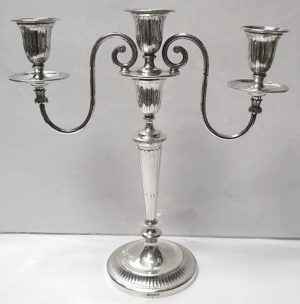
1913
Elkington
6974 Antique Silver Candelebras
Sold
A classic pair of sterling silver candelabra in the 18th century style. Elegant tapering columns on round bases with fluted decoration. The silver tops have an attractive scroll form. Weight of branches 1616 grams, 51.9 troy ounces. The bases are filled. Total height 36.5 cms. Candlestick height 28.5 cms. All pieces fully matching for Sheffield 1913. Maker Elkington & Co.
-

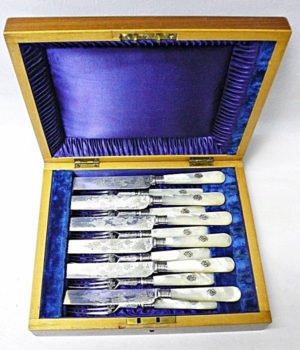
1862
Elkington
8294 Set of Silver Plate and Mother of Pearl Cutlery for 6
Sold
A set of 6 silver plated knives and forks with pretty engraved blades and real carved mother of pearl handles with decorative silver ferules. With an engraved monogram to each handle. Dessert cutlery. Knife 20.5 cms. Fork 17.5 cms. In solid wood box with key (not original). Maker Elkington & Co. Marked with an Elkington date stamp for 1862.
-

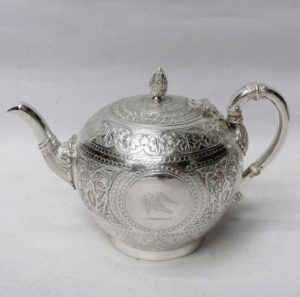
1876
Elkington
8318 Victorian Silver Bachelor Teapot by Elkington
Sold
A lovely little antique sterling silver teapot with hinged lid. Nice small size. Circular bullet shape and all over decorated with flower and leaf designs. Both sides have a hand engraved crest of a bird within a circular cartouche. Contains 500 ml. Weight 281 grams, 9 troy ounces. Height 11 cms. Spread 17 cms. Diameter of base 6.25 cms. Marked underneath for London 1876. Maker Frederick Elkington.
-

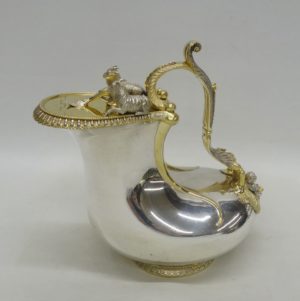
1855
Elkington
9228 Antique Silver Ascos Jug
Sold
An excellent quality Victorian sterling silver jug in the classical Greek ascos form. Part gilded, the lid is mounted with cast figural rams and has a concealed hinge; the ornamental curved handle finishes with a putti at the base. The liquid pours from a semi concealed aperture at the front. Hand engraved to the base is a family crest, monogram and presentation inscription. Contains 1070 ml. Weight 974 grams, 31.3 troy ounces. Height 21 cm. Spread 20 cm. Birmingham 1855. Made by Elkington & Co.
-

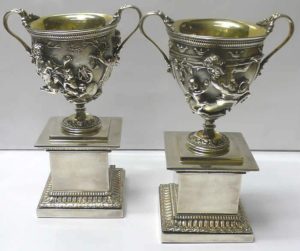
1889
Elkington
6312 Pair of Victorian Pedestal Vases
Sold
Amazing quality. A decorative pair of antique silver plated vases mounted on square pedestal bases. With high relief electrotype decoration of characters from Greek mythology. Height 26.5 cms. Base 16.5 cms. Diameter 11.5 cms. Stamped around the base with Elkington silver plate marks for 1889.
-

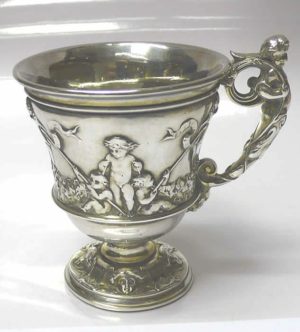
1875
Elkington
7089 Victorian Silver Christening Mug by Elkington
Sold
A delightful antique sterling silver mug with embossed decoration of children and putti. Fantastic quality, even the handle is in the form of a putti, and there are face masks around the base. To the front is an ornamental cartouche (uninscribed). Original interior gilding. No detail has been spared in the manufacture and the mug even has a double skin so that the embossed detail is hidden on the inside. Weight 341 grams, 10.9 troy ounces. Height 9.50 cms. Diameter 8 cms. Birmingham 1875. Maker Frederick Elkington.
-

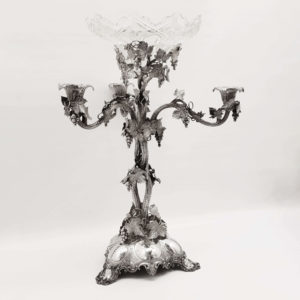
1862
Elkington
9677 Victorian Silver Table Centrepiece
Sold
A spectacular antique silver centrepiece and candelabra, the tall column and arms formed as a grapevine with entwined branches supporting vine leaves and bunches of grapes. The cut crystal bowl and the candle nozzles are all detachable. This decorative item is perfect for fruit, flowers and sweets. Engraved to the base with a presentation inscription from H.G Mytton of Cleobury North. Dismantles into 3 pieces by unscrewing the bowl holder at the top. Weight 2755 grams, 88.6 troy ounces. Height 58.5cm (with glass), 53cm (without). Spread 42cm. London 1862. Maker George Richards Elkington. Sterling silver.
-

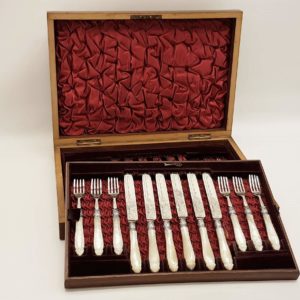
1881
Elkington
9713 Antique Silver and Mother of Pearl Cutlery for 12
Sold
An antique set of sterling silver and real mother of pearl cutlery set having decorative engraved blades with bead ferules. The cutlery has pretty carved handles with carved bead and reed decoration. 12 knives and 12 forks in the original solid wood box. Dessert cutlery. Length of knife 22cm, fork 18cm. Birmingham 1881. Maker Frederick Elkington.
-

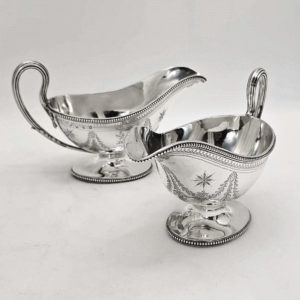
1862
Elkington
9810 Antique Silver Sauceboats
Sold
An elegant pair of antique silver sauceboats with beaded borders. The bright cut engraving is particularly attractive. Each gravy jug has a hand engraved crest to the front of a gentleman holding a scythe. Weight (of both) 423 grams, 13.6 troy ounces. Spread 17.8cm. Height 9cm/11cm. Birmingham 1862. Maker Elkington & Co. Sterling silver.
-

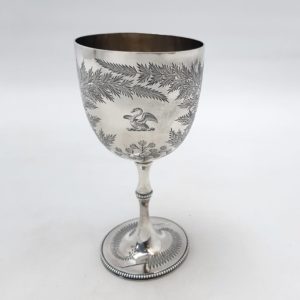
1873
Elkington
10219 Victorian Silver Goblet
Sold
A good quality antique silver drinking cup with a bead border foot. Nice dainty size. Decorated with delicate flower tendrils, leaf engraving to the body, and the crest of a swan to the front. Original gilt interior. Contains 170 ml. Weight 114 grams, 3.6 troy oz. Height 13.7cm. Diameter of top 6.9cm. London 1873. Maker Frederick Elkington. Sterling silver.
-

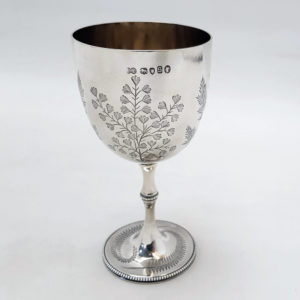
1873
Elkington
10221 Victorian Silver Goblet
Sold
A good quality antique silver drinking cup with a bead border foot. Nice dainty size. Decorated with delicate flower tendrils, leaf engraving to the body, and the crest of a swan to the front. Original gilt interior. Contains 170 ml. Weight 114 grams, 3.6 troy oz. Height 13.7cm. Diameter of top 6.9cm. London 1873. Maker Frederick Elkington. Sterling silver.